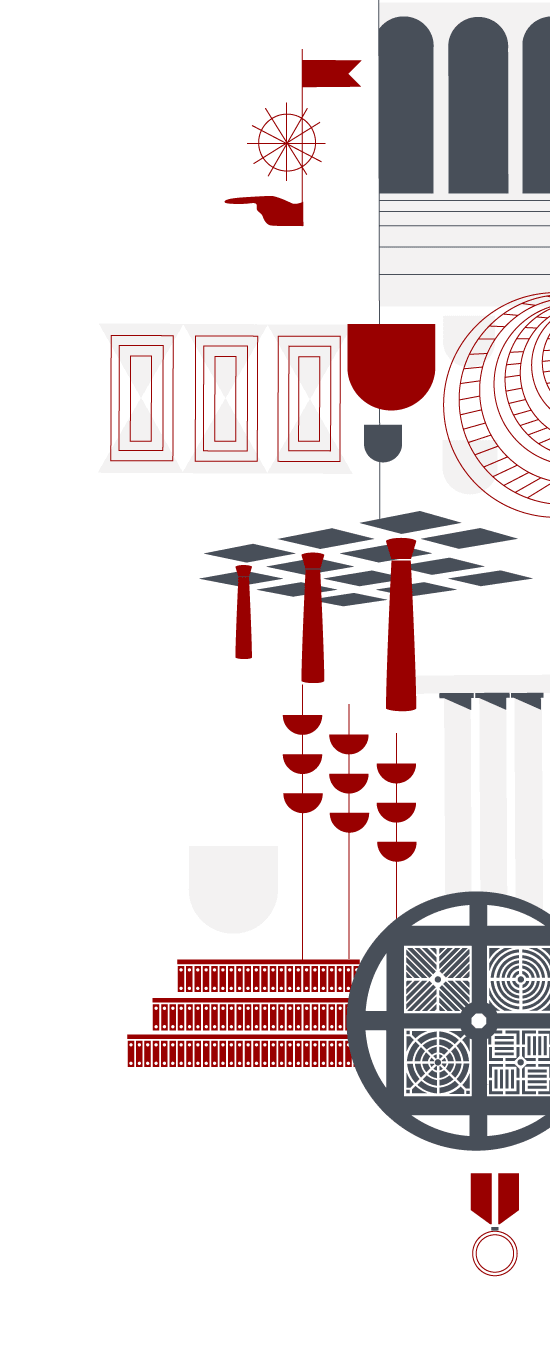
Palazzo Bo and Anatomical Theatre
For Paduans, it had already been a landmark for almost a century: an inn with the sign of the ‘Bo’ – the Ox – had already been mentioned in a document of 1364 under the name of Hospitium Bovis. The name may derive from its proximity to the quarter traditionally occupied by the Bechariarum (butchers) or by the fact that cattle were traded there in former times. But the original core of the Bo is much older, as there were buildings on the site as early as the 13th century; according to scholars, parts of these buildings still exist within the Palazzo.
Strangely, the link between Bo and University may also have its origin in cattle trading: it seems that in 1405 Francesco, heir of the da Carrara family, lords of Padova, donated the building to a butcher who had assured him of regular supplies of meat. In 1539, the University acquired full ownership.
Architecturally, the 16th century was the key period for the Palazzo Bo. The building underwent a process of enlargement and conversion, with work entrusted around 1550 to the architect Andrea Moroni, who was responsible for the main block of the palazzo we see today, with its monumental courtyard. Also dating from the 16th century is the world’s first permanent anatomical theatre. 1446 is the date on the earliest documents mentioning the use of anatomical theatres made of wood, which were erected and dismantled as needed for public dissections. Notable among the great anatomists who taught at the University of Padova is Andreas Vesalius, whose textbook De humani corporis fabrica makes reference to a theatre in the city. It was the anatomist Girolamo Fabrici D’Acquapendente who took the initiative of having a permanent anatomical theatre built. It was inaugurated in 1595 and remained in use until 1872.
The best-known room in the Palazzo Bo is the Aula Magna, the Great Hall. First mentioned in a document of 1399 as the ‘sala magna’ of the Hospitium Bovis, it was a large dining-room: after the University took over the building, it became the Scuola Grande dei Legisti. As a rule, although with a few exceptions – Galileo Galilei was allowed to teach in it – the Aula Magna was the preserve of the jurists. One of the most evocative symbols in the history of the University and of its staff and alumni is undoubtedly the podium which, according to tradition, was used by Galileo itself. It was located in the Aula Magna until mid-way through the 19th century, when it was moved due to renovation work on the hall. The decoration of the Aula Magna as it appears today was completed between 1938 and 1942, with the architect Gio Ponti supervising the work.
The 19th century also saw substantial enlargement of the Bo complex, with the purchase of Palazzo Battaglia (1813).
In modern times, the new wing built after 1910 to house the Faculty of Jurisprudence was the work of Guido Fondelli. An important contribution to the aesthetic renewal of the University was also made by Carlo Anti, rector from 1932 to 1943, who called in artists of great renown – architect Gio Ponti, sculptor Arturo Martini, and painter Massimo Campigli – to apply their skills and talent. A competition for a contract to undertake the renovation of the Bo complex was won, in 1934, by architect Ettore Fagiuoli, who also created the New Courtyard. The talent of Gio Ponti is displayed in many rooms of the Rectorate suite: fittings, paintings and furniture all bear the stamp of the famous Milanese designer, who has given the interiors of the Bo an unmistakable and innovative look.
Palazzo Bo
via 8 febbraio, 2 - 35122 Padova
tel. +39 049 8275111 (switchboard) - +39 049 8273047 (guided tours)


